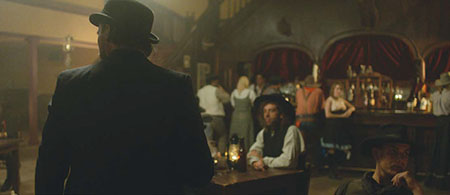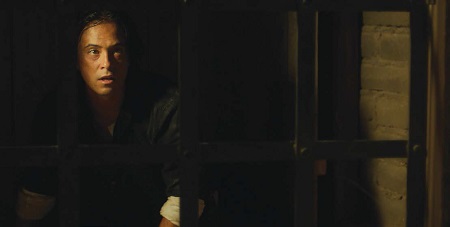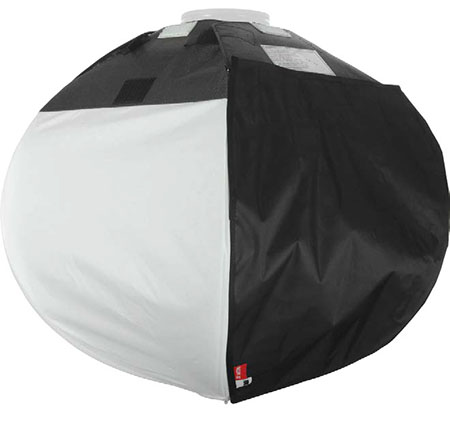Exploring the Power of Omnidirectional Lights
In general, we appreciate lights with direction. We have so much control over where and how a directional source hits a subject. However, with having to shoot out large locations, we sometimes find ourselves needing big, soft sources to create a sufficient ambient light level.
This is an instance where omnidirectional lights are extremely useful. They emit light from the source at every angle. Popular examples are Jem Ball units, spacelights, and Chinese lanterns. The great thing about these is that you can switch out the bulb inside and use a variety of different wattage systems for a weaker or stronger output.
SPACE LIGHTS
In a studio environment—especially one with a greenscreen—spacelights are often rigged overhead to create a general fill and evenly light the screen behind the subjects for exposure. More directional units are then used to be specific keys and edges.
On shows with more even lighting, such as sitcoms, spacelights can be effective throughout different rooms of a set to light actors as they move through the space and to ensure that parts of their surroundings do not fall off into shadow.
You can also put a variety of types of bulbs inside, from tungsten bulbs to HMIs like a 400W Joker with a simple adapter. I have seen Kinos and other panels above that work well, too, as an overhead grid to fill a space, but often come with a lot of flags and other grippage alongside them to cut the light and avoid creating shadows.
I find that, in general, if you can do bigger, softer sources, shadows are minimized and they can often present less problems than one would think they may cause.

Scene from “Cassidy Red” using a grid of china balls Using the same overhead rigging, with smaller bulbs inside lanterns like china balls, a lowlight grid can be created for ambient light.
On my latest feature, “Cassidy Red,” I deferred to omnidirectional units a lot. Being a western period piece, there was no electricity in the world on screen, so the soft glow that these could give me was ideal.
Every warm source was typically motivated by actual firelight in kerosene lanterns. The largest set on that production that I had to tackle was a large saloon with extremely high ceilings. The first initial thought to bring up the ambience was to bounce units into a 12x12 bounce rigged up on the ceiling.
Of course, we knew this would not end up serving us well because we would then have stands to hide, and with a lot of fluid camera movement on the floor, these would be impossible to avoid seeing in frame. We ended up building a grid of china balls, most on-hand dimmers, to create a soft overhead source that successfully brought up exposure in the room. I was able to use that as a starting point to then light from the floor when it came time to give actors dimension.

Also from “Cassidy Red,” Swain used a single china ball in this scene.JEM BALLS AND CHINESE LANTERNS
Soft sources also serve as very pleasing key lights, and what I have found over the years is how beautiful omnidirectional sources like Jem Balls and Chinese lanterns are as keys, despite their lack of direction. They are naturally made to diffuse and spread light, without having to bounce a source back at your subject or shoot it through separate diffusion.
In a minimalistic lighting approach, a soft key and ambient fill can be achieved simultaneously with something like a china ball. In “Cassidy Red,” I used a single 12-inch china ball in a jail scene where a character emerges from the darkness. Nothing else was flown. These warm sources are so versatile.

chinese lantern Another popular use is to light a group of actors with them at a table, where you have to key multiple people. By simply righting a single Jem Ball or lantern in the center of a table, you can key all or most of your actors. The wrap of light that can be accomplished with lanterns is great.
I often arm out a china ball and then bring it up and down depending on eye lines so that it hits faces nicely and catches the eyes. If you wanted to lose the ambience level that it gives because it is naturally spilling light everywhere, a skirt can be created at the top of the lantern to contain the source a bit.
Overall, omnidirectional units are extremely useful. I recommend considering them when dealing with both large and small spaces, as they come in a range of size and output options. It is hard to go wrong with soft light, and being able to call upon these types of sources can easily help you achieve the look you are going for.
Julia Swain is a cinematographer based in California, whose narrative films include “Killing Animals,” “Jilted” and “Cassidy Red.” Her latest feature film, “Women of Light” will premiere in late 2016. She continues to shoot on a variety of formats, seeking to create compelling visuals for every story and brand. She can be reached atjuliaswaindp@gmail.com.
Get the TV Tech Newsletter
The professional video industry's #1 source for news, trends and product and tech information. Sign up below.
